Keep on truckin’ on bike and on foot. And in taxis?
March 18, 2010
If the people behind the 2010 LA Street Summit have their way, four wheels would become two.
Or none at all.
Scheduled for Saturday, March 20 at Los Angeles Trade Technical College, near downtown L.A., this year’s meeting broadens the discussion from an earlier bike summit to include mass transit, walking and even taxicabs. The Urban Environmental and Policy Institute of Occidental College, the summit’s creator, hopes the gathering will spark enthusiasm for the growth of “green and community based” styles of transportation.
“We’ve got a system weighed heavily in favor of automobiles,” said Joe Linton, program associate for the UEPI and an avid cyclist. “For Los Angeles to have a healthy environment and a lessened environmental impact, we need to give people other options.”
The summit kicks off Thursday, March 18 at 7:30 p.m. in Occidental College’s Keck Theater with a lecture on energy and the environment by Janette Sadik-Khan, Commissioner of Transportation for New York City, which rolled out 200 miles of new bike lanes in the past three years.
Saturday’s programs will be interactive and geared towards a broader community of alternative transportation enthusiasts. Workshop discussions include street-ready topics such as:
* “How Free Parking Gets in the Way of Building Livable Cities” by increasing car congestion and discouraging alternative transportation
* “Subverting Urban Planning” through increasing the number of parks with more places to sit, along with other people-friendly features
* “What the Hell is Going on in Long Beach?” (Partial answer: new bike lanes and shared bike-car-bus lanes)
The summit starts at 10:00 am and goes through 5:00 pm. Admission is free.
The event will also feature artwork by local artists and food from street vendors.
“The fact that this year has been expanded [beyond bikes] is a major leap forward,” said Allison Mannos, Urban Programs Coordinator for the Los Angeles County Bike Coalition. “It’s pretty revolutionary.”
Skirball hosts RFK’s “Journey to Justice” this week
March 18, 2010
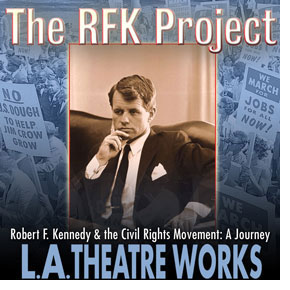 It was among the briefest reigns in pop culture history, but the Golden Age of Radio spanned barely 25 years between the late 1920s and the mid-1950s, when the advent of commercial television rang down the curtain on radio’s theatre of the mind. Future generations of listeners largely lost their opportunity to savor the pleasures of the audio art form. But since 1974, radio drama has been alive and well in Los Angeles thanks to L.A. Theatre Works, a performing arts organization established to produce, promote and preserve radio dramas for entertainment and education.
It was among the briefest reigns in pop culture history, but the Golden Age of Radio spanned barely 25 years between the late 1920s and the mid-1950s, when the advent of commercial television rang down the curtain on radio’s theatre of the mind. Future generations of listeners largely lost their opportunity to savor the pleasures of the audio art form. But since 1974, radio drama has been alive and well in Los Angeles thanks to L.A. Theatre Works, a performing arts organization established to produce, promote and preserve radio dramas for entertainment and education.
LATW produces ten new radio plays a year, performing and recording them in front of a live audience at the Skirball Cultural Center in Brentwood for later airing on its nationally syndicated radio series, which airs locally in Southern California on 89.3 KPCC every Saturday from 10 pm – midnight. The programs can also be heard as free streaming audio, borrowed from public libraries and purchased on CD or as audio downloads.
This week, L.A. Theatre Works premiers its latest work, “RFK: Journey to Justice,” a new docudrama chronicling Robert Kennedy’s personal and political odyssey through America’s tumultuous civil rights era of the early 1960s. His story offers a compelling narrative of his evolution from conventional political animal into an inspiring leader in pursuit of a higher cause.
The Skirball live performances are now running through Sunday, March 21, 2010 weekday evenings at 8 p.m., with a Saturday matinee at 2:30 p.m. and Sunday matinee at 4:00 p.m., at ticket prices ranging from $20-$48. For further information, call
(310) 827-0889.
Posted 3/18/10
A fabled route for the long run
March 17, 2010
Sunday’s L.A. Marathon will blaze a new trail across the city, racing past some of the most storied real estate on the planet—Dodger Stadium, El Pueblo de Los Angeles, Hollywood & Vine, Grauman’s Chinese Theater, the Sunset Strip, Rodeo Drive.
But to L.A.’s running cognoscenti, all that might as well be the low-rent district compared to the race’s closing stretch: San Vicente Boulevard to the ocean.
“A mecca,” says Gabriel Valenzuela, who has been running San Vicente for 25 of his 65 years. “It’s the pinnacle.”
Despite its legendary status among local runners, this slice of workout paradise, with its coral tree-studded center islands and easy-on-the-knees grass, is only now making its L.A. Marathon debut. With a sell-out crowd of 25,000 marathoners registered to take part this year, the allure of San Vicente—never a particularly well-guarded secret among the Westside’s fit and fabulous—is about to be shared with the world in a big way.
So you could forgive these running regulars for feeling a twinge of locals-only resentment at the coming invasion. But (and maybe this was just the endorphins talking) nearly everyone interviewed on a recent Saturday morning starts by saying the same thing: “I think it’s great!”
Or this, from Ken Carlson, running with his wife, Katrina, near the intersection of San Vicente and 7th Street in Santa Monica: “Bring it on! Civic pride!”.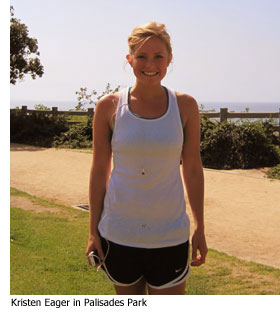
In addition to providing an injection of that feel-good civic pride, the 26.2-mile marathon is guaranteed to deliver its share of you-can’t-get-there-from-here moments, so be prepared. Metro is warning of bus service disruptions in areas traversed by the route, and urging spectators to take the train to marathon viewing points. That information is here. Motorists, too, should check out street closures.
The 25th annual marathon, with its “Stadium to the Sea” route, also will force some alterations in long-cherished workout routines. “Every Saturday and Sunday, I drive out to Santa Monica to run” along San Vicente, says Jack Rosenfeld, 30, of Culver City. Not this Sunday. “I’ll be watching on TV, probably,” he says. (KTLA Channel 5 will be televising the marathon from 7 a.m. till 10 a.m. Sunday.)
For runners, the stretch brings together an almost magical combination of factors. Good air. A nice downhill grade toward the ocean. The grassy median. Those coral trees—gnarly roots notwithstanding. And long stretches uninterrupted by cross traffic.
“Everybody from the Westside who works out regularly knows this stretch,” says Mark Stofko of Hollywood, pausing briefly at the 7th Street light with fellow runner Andreas Deptolla.
San Vicente is the stuff of local legend in other ways, too. A 1980 Los Angeles city ordinance designated the Brentwood stretch a scenic corridor and created one of the city’s pioneering “specific plans” to protect and preserve the neighborhood’s character by limiting the scale of development.
The coral trees themselves, planted in the 1940s along what was once the Red Car corridor, were designated a city historic-cultural monument in 1976.
The “Kaffirbloom corals”—Los Angeles’ official trees—have endured various threats over the years, including a time in 1995 when 11 had to be chopped down, and dozens more appeared to be in danger, because of top-heaviness, according to the Los Angeles Times. (The problem was resolved by giving the luxuriant Brentwood trees a buzz cut.)
More well known than the boulevard’s running culture, at least for a time, was its role as a geographical footnote during the O.J. Simpson murder case. The restaurant Mezzaluna—where Nicole Simpson dined before she was murdered and where Ronald Goldman, also slain, was a waiter—was located on San Vicente. Now it’s a Peet’s Coffee & Tea—a popular stop for local runners and, even more, for the bicyclists who share the boulevard with them.
The 4.03-mile stretch of San Vicente that the marathoners will be pounding Sunday is part of a new route that, for the first time, will go through cities in addition to Los Angeles, including West Hollywood, Beverly Hills and Santa Monica. The Santa Monica City Council’s approval was essential to making San Vicente the race’s portal to the Pacific. More than 3,000 people signed an online petition urging the council’s OK last summer.
The new route—along with the race’s new management under Frank McCourt, owner of the Dodgers—helped make this year’s race a sellout for the first time ever, according to Rich Perelman, spokesman for the event.
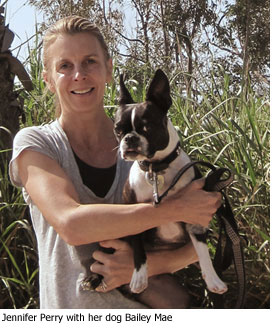 It certainly made a difference to Jennifer Perry.
It certainly made a difference to Jennifer Perry.
Perry, executive director of the nonprofit Children’s Action Network, is a San Vicente regular who’s previously run marathons in New York, Paris and London—but not here at home, until now.
“The only reason I’m running is because they changed the route,” she says. (Another factor: her 50th birthday is Sunday, so why not?)
She hasn’t practiced running the overall new route—“I prefer to be surprised”—but seems delighted that she’ll be passing some personal landmarks along the way.
“I can stop at my coffee place,” Perry says. “It’s at Mile 22.”
At Palisades Park, where San Vicente meets Ocean Avenue, Perry and her sometime running companion, a two-year-old Boston terrier named Bailey Mae, are having a laid-back stroll Saturday morning, the heavy-duty marathon prep completed. It’s choice spot to kick back and take stock.
“To me,” Perry says, “this view of the ocean epitomizes L.A. It epitomizes why we live here.”
Nearby, Kristen Eager, a 21-year-old UCLA math major, is finishing her post-run stretching near the base of San Vicente, the Pacific sparkling behind her in the distance
“We should be showing this off for the marathon,” Eager says. “It’s beautiful.”
This ad’s for you, if Metro shifts gears
March 17, 2010
It’s been 13 years since they dimmed the lights and sounded last call for beer and wine advertising on local buses and trains.
Now those ads could be on tap again.
A proposal to bring back such advertising goes before a Metropolitan Transportation Authority committee this week. The idea has surfaced as Metro faces a $181 million deficit—and likely staff cuts and service reductions–in the coming fiscal year that begins in July.
CBS Outdoor, Metro’s advertising vendor, said it would split the revenue generated by the new beer and wine advertising with the agency, generating about $500,000 a year for Metro, according to the report to be considered by the Executive Management and Audit Committee on Thursday. That amount would be on top of Metro’s revenue from other CBS Outdoor advertising, which is set at a flat fee of $27.9 million in the coming fiscal year.
Ads for tobacco and other alcoholic beverages would remain off-limits.
Warren Morse, Metro’s deputy executive officer for communications, said the idea of reinstating beer and wine advertising originated with CBS Outdoor and was being presented to the committee as one possible revenue-generating option.
“We didn’t bring this up to be controversial,” he said. Morse said that the cities of Los Angeles, West Hollywood and Inglewood allow beer and wine advertising on bus shelters in their areas, which account for 85% of the shelters in the county.
Metro banned tobacco and alcohol advertising on its vehicles in April, 1997, on a motion by then-Supervisor Yvonne Brathwaite Burke, who was also on the Metro board of directors at the time. (The current policy is here. )
Burke, who retired in 2008, said in an interview that she had introduced the motion as a matter of good health policy. She said public transportation passengers are a captive audience, and alcoholics, in particular, could be placed in a difficult situation if they are unable to avoid seeing such ads.
“You have an audience that is almost kidnapped,” Burke said. “I just wonder how much money is going to be generated to make it worth it.”
Metro riders interviewed this week seemed divided on whether beer and wine ads should be allowed to share their afternoon commute.
“I don’t want to see it,” said Red Line subway passenger Joe Barry. “There is already enough exposure. I don’t see why it has to be featured down here as well.”
“I don’t need to have it in my face every minute of the day,” added Paul Donaldson, another Red Line rider. “I can get that enough from TV.”
But Avis Jackson, riding the Purple Line, said, “It doesn’t matter because the advertising is everywhere else and is so overexposed.”
Added Michael Paz, waiting to board the Purple Line: “It’s fine with me if it creates some money for the city.”
CBS Outdoor senior vice president Rich Ament said the change makes financial sense. He said beer and wine advertising represents a “serious opportunity” for Metro to receive revenue from what is “essentially a recession-proof product.”
“Beer and wine advertising is everywhere,” Ament said. “The only place it doesn’t exist is on the (L.A.) transit system… It exists pretty much everywhere else.”
New York’s Metropolitan Transportation Authority is among the big city transit systems that allow such advertising. But San Francisco’s does not.
“Tobacco and alcohol advertising are seen as not appropriate on public transportation vehicles that are publicly funded,” said Murray Bond, deputy director for communications at San Francisco’s Municipal Transportation Agency.
Posted 3/17/10
A veterans residence worth waiting for
March 11, 2010
Steve Rosmarin pushed for 20 years to get a state long term care home for veterans built in West Los Angeles.
Now that it’s finally scheduled to open this summer, he’d love to be among the first to move in.
Rosmarin, a retired stockbroker and travel agent, is a very unretiring veterans’ activist. At 82, he’s twice been state commander of the Jewish War Veterans, once in the early 1960s and again in 2007-8. Since 1999, he’s served on the county’s Veterans Advisory Commission.
Not a bad achievement for a one-time private first class who served in Korea in the early days of the Cold War, hunting for Japanese holdouts and worrying about the Russians north of the 38th parallel. The slight teen carried a BAR, a Browning Automatic Rifle, a powerful weapon that weighed more than 18 pounds. “They liked to give the short guys the big weapons,” he explains.
As a veterans’ advocate, he has long pushed for advances in education, health care and housing for former military personnel in the Los Angeles area. The housing issue became important to him as he watched as veterans of World War II, Korea and, more recently, Vietnam hit retirement age, and face scarce housing options on fixed incomes.
“We have so many veterans here that are aged and in need of housing and care,” he says. “We needed to do something.”
In the late ‘80s, Rosmarin and other advocates figured the best solution was building a state veterans home in L.A, now home to about 400,000 vets. At the time, there was just one state retirement residence for vets operated by the California Department of Veterans Affairs, a large home in the Napa Valley community of Yountville – hundreds of miles away. In the ‘90s, two new state homes were built, but neither was close to Los Angeles, with its large veteran population.
He lobbied members of Congress, veterans’ officials and Sacramento lawmakers to locate a facility on the federal Veterans Affairs campus in Westwood. The area had spare land and proximity to the veterans hospital and the UCLA Medical Center. And, after all, the VA campus had started in the 1880s as the Sawtelle Veterans Home for disabled military men. Locating a facility there meant the vets could more easily stay connected to family and friends.
Their campaign got a big boost when federal Veterans Affairs officials declared California one of two states “in great need” for veterans’ housing and required new homes to be built in areas with high concentrations of veterans. The state passed bond funding between 2000 and 2004, and a building plan emerged to construct five new state homes with both state and federal funds—three of them in Los Angeles and Ventura counties.
Rosmarin’s key role was evident at the 2007 groundbreaking, when he got the call to introduce Gov. Arnold Schwarzenegger.
The 396-bed Veterans Home of California–West Los Angeles facility will open this summer. The $187- million home will include a residential care wing as well a skilled nursing facility and a “memory care unit” for vets with Alzheimer’s or dementia. Two other smaller Southern California facilities–60-unit residences in Lancaster and Ventura–also opened in recent months.
When the application period began last month for the West L.A. home, Rosmarin, who until recently had been living on his own in the San Fernando Valley, quickly put himself in the running. He wants to be closer to his two daughters and his L.A.-area roots in Sherman Oaks and West Hollywood. He moved into the new state veterans’ home in Lancaster in the past few weeks—temporarily, he hopes. Widowed three years ago, Rosmarin had wanted to wait until the West L.A. facility opened to make the move, but he had to make the jump early when his doctor recently told him that his health and medication issues meant that he should no longer be living alone.
He’s not the only one interested. More than 700 veterans have requested applications to the West L.A. facility, according to spokeswoman Jeanne Bonfilio. Veterans must be California residents, 62 or older and honorably discharged. Disabled vets can be younger. The rent covers room, board and all services. Rates vary, ranging from 55 to 70 % of a veteran’s income, depending on the level of care in the facility.
After getting a taste of living in a state home, Rosmarin is an even bigger booster, touting them as clean, well-operated alternatives to costly private sector facilities. “I’ve visited several [private facilities], and you always get the smell of hospitals and the smell of other things,” he says, speaking by phone from what he hopes will be his temporary bivouac in Lancaster. “Here it smells spotless. It’s a great thing to see.”
State budget mess to be aired in WeHo
March 11, 2010
Confused about the state’s $20 billion budget gap? Want to find out what state cutbacks will do to local services? On Friday, March 12 at 10 a.m. in West Hollywood, State Sen. Fran Pavley has invited state Legislative Analyst Mac Taylor, Supervisor Zev Yaroslavsky, West Hollywood Councilmember John Duran and others to address her State Budget Town Hall. There’s no shortage of urgent topics commanding public attention in the current economic crisis and the Governor’s 2010-11 proposed budget.
See this map for directions to Fiesta Hall at West Hollywood’s Plummer Park, 7377 Santa Monica Boulevard, or call Callie Hurd in Sen. Pavley’s office at 310-314-5214 for further details.
Posted 3/11/10
Bus riders to be affected by 405 project, too
March 11, 2010
Some Westside bus passengers will soon be taking the scenic route.
And Metro would like to apologize for that in advance.
Starting in mid-March, patrons of various Metro bus lines in the Sepulveda Pass and West Los Angeles could be facing delays and detours due to the 405 Sepulveda Pass Widening Project, which will add a 10-mile northbound carpool lane to the freeway.
Bus lines that travel on the freeway and through the construction area will be affected off and on until the project’s completion, now scheduled for 2013.
Lines slated to be affected are as follows:
• Line 2-302: Sunset Boulevard
• Lines 4 and 704: Santa Monica Boulevard
• Lines 20, 720 and 920: Wilshire Boulevard
• Line 761: Sepulveda Boulevard and 405
Regular updates are available on Twitter.
Posted 3/11/10
Making sure bicyclists count on the Orange Line
March 11, 2010
 The census has competition—and they’re offering pizza.
The census has competition—and they’re offering pizza.
Metro is seeking volunteers to help conduct a survey of bicyclists, riders and pedestrians on the bikeway next to eight Orange Line stations on March 24 and 27.
To sweeten the deal, they’re hosting a training/orientation session at the Pitfire Pizza in North Hollywood on Monday, March 22 at 7:00 p.m. The pizza’s free and so are the volunteer T-shirts (though you will have to spring for your own beverage.)
The goal is to “document the environmental sustainability benefits that the Metro Orange Line and integrated bikeway have generated since its opening in 2005.”
Those interested in taking part should sign up here.
Posted 3/11/10
An artful setting for an urgent mission
March 10, 2010
When artists meet with mental health clients to get a sense of how a psychiatric urgent care center should look and feel, the clients don’t hold back.
“Don’t use any really bright colors—and definitely don’t use any red.”
“Being in nature makes us calm down and feel good.”
And that institutional grey metal file cabinet over there? “That is exactly what we don’t want to see.”
For artists Amy Trachtenberg and Jeffrey Miller, those conversations were a welcome validation of many of their ideas on color, nature, material and mood.
They also form an essential element in an extraordinary collaboration that will begin to take shape later this month when construction begins in Sylmar on the new facility, with the proposed name the Olive View Community Urgent Care Center.
Not so long ago, the aesthetics associated with mental health facilities were at best coldly clinical, at worst something out of “One Flew Over the Cuckoo’s Nest.”
The Olive View project aims to make a sharp break with all that.
The Mission-style project, which breaks ground on March 17, is the culmination of years of work by a county team that has made art and design central to its exploration of how the look and feel of the new building itself can play a role in the treatment of patients in psychological distress.
From color palette to carpet pattern, no detail has been too small for the county team working with the artists and architects HMC and gkkworks. The multifaceted working group includes representatives from the departments of mental health and public works, the arts commission and deputies from the offices of Supervisors Zev Yaroslavsky and Michael D. Antonovich. (A 2004 motion by Yaroslavsky, followed by another motion he authored with Antonovich a few weeks later, got things rolling on bringing psychiatric urgent care to an underserved area.)
The new facility is part of a larger movement to bring high-quality art into hospitals and other health care facilities not just as decoration, but to help in the treatment process.
Diane Brown, the founder of RxArt, a New York nonprofit that specializes in bringing contemporary art into medical settings across the country, says that hospitals were wary when they started nearly 10 years ago.
“When we did our first project, we had a hard time getting our foot in the door,” Brown says. “It was free, museum-quality art, and we couldn’t give this stuff away…Now hospitals call us up. We don’t have to beg anybody.”
RxArt, which is planning to place a Jeff Koons installation in the CAT scan room of a children’s hospital in Chicago, has worked on an inpatient psychiatric ward and has an upcoming mental health urgent care project of its own coming up, at New York’s Kings County Hospital.
“You have to be so careful with what you’re putting in,” Brown says of such projects. “Something I thought was perfect was just completely inappropriate.”
On the opposite coast, such considerations are front and center during a meeting to determine tile, paint and flooring choices for the new Olive View urgent care. A certain shade of green draws comments like “I’m thinking psychiatric hospital circa-1965 throwback.”
At the same meeting, someone asks whether blue should be ruled out as a “depressive” color.
James Coomes, the mental health department’s program head for Olive View urgent care, quickly responds to that one, saying that in this kind of treatment setting, “it’s really the bright red that we were concerned about. If someone’s agitated, we want to bring them down.”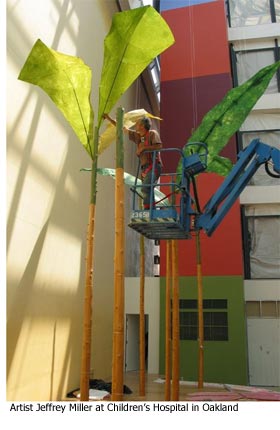
Such nuances are crucial when you’re creating a space for the relatively new concept of mental health urgent care. The facility must serve patients too troubled to wait weeks for a simple counseling session but who may not need full-on psychiatric emergency room treatment. Clients could be people experiencing the onset of schizophrenia, a serious bout of depression, or a traumatic event. Many, if not most, have substance abuse problems as well.
“We can decompress the psychiatric ER [at Olive View-UCLA Medical Center] if we do our job right,” Coomes says.
Even without a permanent home, the county’s mental health urgent care operation in the San Fernando Valley has been seeing a growing caseload: from 832 cases in 2006 to 1,570 cases last year.
One of those clients, William O’Reilly, says the urgent care staff threw him a lifeline when he was in the throes of a profound depression.
“That place saved my life,” says O’Reilly, 47. “There was so much compassion shown…That’s fantastic that there’s going to be a new facility.” When the new urgent care opens, the county aims to treat more than 3,000 clients a year there.
The input from clients—part of a day-long tour for the artists–came from residents at the county’s Hillview intensive residential center, for homeless people who have received mental health treatment.
“This was really quite a wonderful thing for us,” Trachtenberg says. “We got to learn the kinds of things they are drawn to and what repels them.”
The artists—who are a married couple as well as professional partners on this project—say they drew on a wide range of influences, from Ayurvedic medicine to “sacred geometry” and classical allusions, to create the Olive View plan.
“Our goal is to try to create a kind of calming, restorative place,” Trachtenberg says. “We really drew from various cultures…timeless forms, ancient forms, a response to nature and to geometry—an approach both ornamental and restorative that hopefully will lift the spirit.”
“The staff was important, too,” says Miller, who is also a landscape architect. “They were making sure we were aware of certain color relationships.”
While psychiatric urgent care is offered elsewhere in the county, including St. John’s Hospital in Santa Monica and the Augustus F. Hawkins Mental Health Center in South Los Angeles, Olive View will be the first stand-alone facility to be built specifically for that purpose.
 The $10.8 million, 10,800-square-foot project—which aims for LEED silver certification for its environmentally sensitive building practices—is also the first in the county to incorporate the artists’ concepts in the plan from the very beginning of the process.
The $10.8 million, 10,800-square-foot project—which aims for LEED silver certification for its environmentally sensitive building practices—is also the first in the county to incorporate the artists’ concepts in the plan from the very beginning of the process.
“It’s really been great having this team effort—not just coming in after the fact and plunking in some art,” says Carrie Brown, a civic art project manager for the county Arts Commission who has been working on the Olive View project for the past three years.
Integrating art into new projects took off with the enactment of the county’s civic art policy in 2004. Since the 2005-2006 fiscal year, 1% of the design and construction budget for capital projects must be allocated to art in and around the new developments.
When it came to selecting the artists for Olive View, the San Francisco-based Trachtenberg and Miller drew high marks for their experience. They’ve previously worked on projects including an atrium at Children’s Hospital in Oakland and a multi-faceted art installation for the rotunda of the Hillview Library in San Jose. Trachtenberg also served as the sole visual artist on a mayoral advisory panel for the suicide barrier on the Golden Gate Bridge.
But in the end, it was their artistic approach as much as their track record that won over the staff at the department of mental health.
In fact, mental health staffers were amazed when they first saw the interlocking circles motif incorporated into the project’s signature stepping stones.
Had the artists gotten a look at their treatment playbook?
The design looked like a direct homage to the “family systems theory” pattern at the heart of their therapeutic model—in which patients are linked with family and other support sources.
“They were sure that we had studied their diagrams,” Trachtenberg says.
Work on the Olive View art elements—which, in addition to the stepping stones, will include a painted frieze on wood panels, suspended sculpture, and a 49-foot “horizon sliver” composed of polycarbonate panels—is set to begin this summer. Trachtenberg and Miller are planning to install their work right after construction finishes in the summer of 2011.
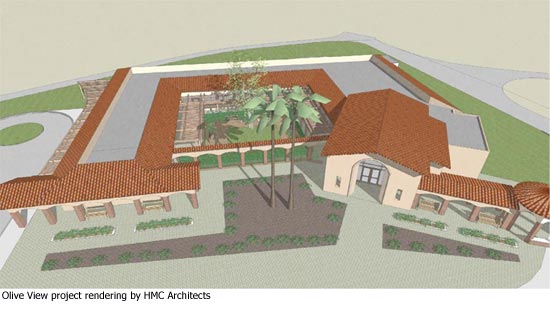
The new facility can’t open soon enough for the staffers who will work there.
It’s been five years now since the phalanx of psychiatrists, social workers and nurses, caseworkers and community workers attached to the urgent care program squeezed into “temporary” borrowed space at the San Fernando Mental Health Center. That has meant five years of working in “submarine-like conditions,” often with little privacy as they seek to diagnose, treat and refer desperately troubled clients.
“This is stolen space. Actually, more begged and borrowed space,” Coomes says on a tour of the facility, introducing a small team of case managers and community workers charged with staying in touch with clients and making sure they are scheduled for follow-up visits.
The group’s supervising psychiatrist, Dr. Jeffrey Marsh, recently gave up his office to a junior colleague who sees more patients than he does. Marsh has a cubicle now. As for ambiance, well, it’s safe to say that a high point may be the Sigmund Freud action figure he’s put up on the wall.
Working conditions aside, what’s most important to Coomes, Marsh and their colleagues is being able to offer clients—and their families—a tranquil and healing environment to come to at a frightening and stressful time.
“To create an atmosphere that’s safe, calm and pleasant is really important for the population,” Marsh says. “There aren’t a lot of places like that.”
Posted 3/10/10




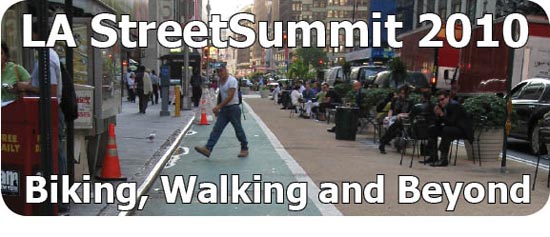
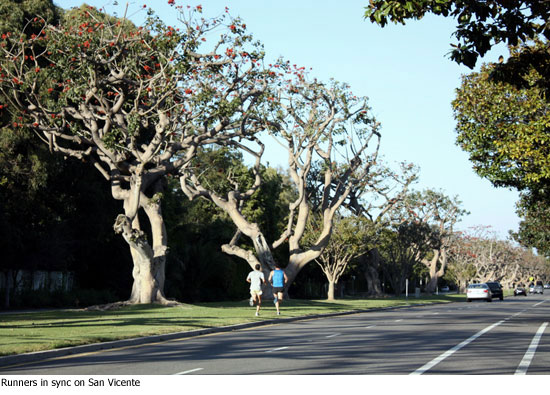

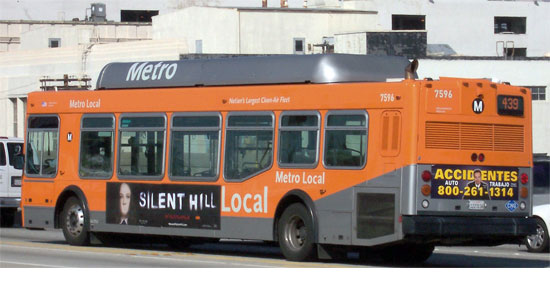
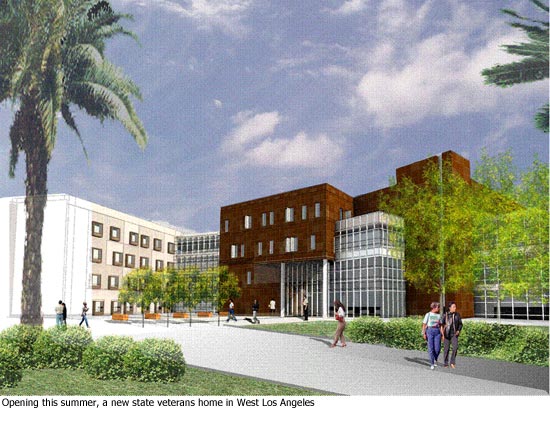
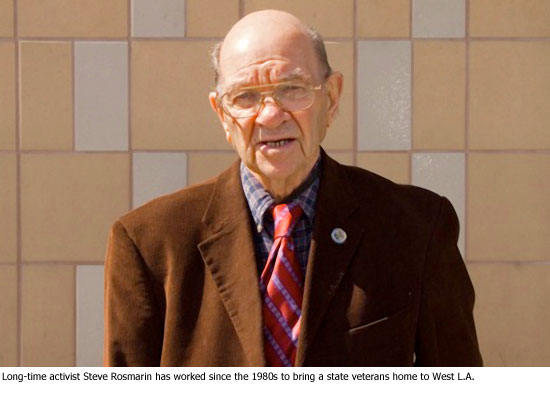


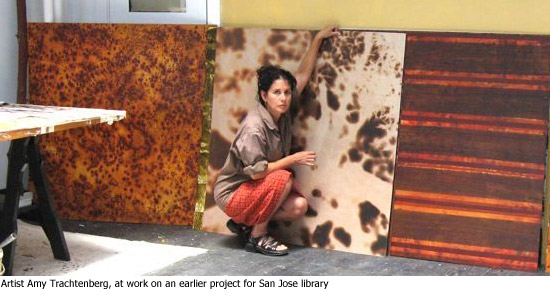





 Check for the latest closure information
Check for the latest closure information








